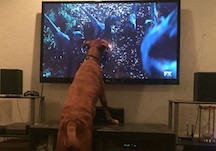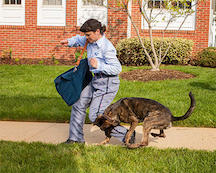Is Technology Harming Our Pets?
Dr. Jeremy Turner, Professor of Psychology and Neuroscience at Illinois College
 Dr. Jeremy Turner, Professor of Psychology and Neuroscience at Illinois College, studies the sounds that humans can't hear, but that may be loud and clear and maybe even annoying to your pets. Dr. Turner says the proliferation of electronic devices introduces un-heard noise that can actually stress our furry companions.
Dr. Jeremy Turner, Professor of Psychology and Neuroscience at Illinois College, studies the sounds that humans can't hear, but that may be loud and clear and maybe even annoying to your pets. Dr. Turner says the proliferation of electronic devices introduces un-heard noise that can actually stress our furry companions.
Technology has come a long way and you can find it in almost every home. So could the sounds from computers, light bulbs, etc., be harming our pets? We may never know exactly what our animals hear that we don't hear, but we can always take a stab at it.
Dr. Jeremy Turner studies ultrasonic hearing primarily in rodents. He's interested in deafness and understanding how humans hear. He's also interested in how hearing goes bad, such as when someone gets tinnitus, which is ringing in the ears. He wants to figure this out, so through the process of studying hearing in mice and rats, he's essentially come to understand that the animals that are in our lives are hearing sounds that we have no idea about. They have a hearing range that extends far higher in pitch than ours. This is for good reason. Dr. Turner explains that there is a good relationship between head size and how high a frequency you can hear. So for example, the smaller the head of the animal, the higher pitches they can hear.
Little bats, for example, can vocalize really well. Little mice can hear up to 100 to 120 hertz. Then the bigger animals, like elephants, they hear low frequency sounds. So it has to do with a couple of factors. They think the biggest reason for that is that it helps them localize sound. Hearing high frequencies is really important if you've got a little head. And if you need to localize where sounds are coming from, you can actually measure in your brain the time it takes sound to travel from one ear to the next. You can also tell the change in pitch as it hits the head on one side and only some of that sound gets to the other. So the little animals in our lives hear sounds that we don't.
Increasingly the technology that we're bringing into our lives, it turns out, is creating a lot of ultrasonic noise. This technology can include computers, televisions, pretty much anything with a little motor in it or little electronic switching circuit boards. These things generate these high pitch sounds that we're not aware of.
So could we be stressing out our animals with sounds that we're not aware of? According to Dr. Turner, yes, sound is a great way to stress out mammals. If you've ever had a baby in the house you know that's the case!
 Sound is also a great way to communicate in the dark and around corners. Because of this, a lot of animals have aversion calls so that they can warn their friends if there's something bad in the neighborhood. And it's not just pitch, from low frequency to high, it has to do with intensity as well and how loud it is. Obviously, a louder call is more arousing than a more quiet call of course. And a lot of times our environments are absolutely just filled with noise and we just adapt to it. We get used to it. We at least tell ourselves that we do.
Sound is also a great way to communicate in the dark and around corners. Because of this, a lot of animals have aversion calls so that they can warn their friends if there's something bad in the neighborhood. And it's not just pitch, from low frequency to high, it has to do with intensity as well and how loud it is. Obviously, a louder call is more arousing than a more quiet call of course. And a lot of times our environments are absolutely just filled with noise and we just adapt to it. We get used to it. We at least tell ourselves that we do.
However, below the surface, our biology is impacted by this noise. Our heart rates are higher if we're in a noisier environment. We know that people in a loud workplace have higher risks of cardiovascular dysfunction, they make more errors in data entry and they are more anxious. We might feel like we have it under control sometimes, but even sounds that are in our environment that we're just not even psychologically aware of, are impacting us. They could also be doing the same thing to our pets. And so for our cats and dogs at home, we might be bathing them in sounds of course that we can hear, but also many sounds that we can't.
We're learning about sounds we can't hear that are pets can hear, but what about things they can see that we can't? For example, LED lights flicker. Humans can't see it, but they do go on and off and are at a rate that maybe dogs can see? One of the problems with LED lights is that you can get them to emit different wavelengths and different colors of light along the spectrum. Different species are sensitive to different wavelengths. Humans have a color vision that is of the three basic varieties and we know that other species have differences so that they can see some colors but, but in different ways. Dr. Debbie was concerned about LED lights because she recently switched all of the light bulbs in her home over from the old incandescent bulbs to LEDs. Dr. Turners says that unfortunately this is one of those things that you can't hear. However, he tells us he has developed some equipment that he sells measure these sounds.
Unfortunately measuring this kind of thing can be somewhat expensive, because you have to have these really high-end microphones that are sensitive to these high pitch sounds. But, if you turn on a device and if you've got a pet within a few feet of the device and you notice them turning their head or doing something different as a result, you can be pretty sure that they heard it.
Dr. Turner explains that sound drops with intensity pretty significantly. So high-pitched sounds, especially if they are generating from a light or a computer, if you're a few feet away, it drops really noticeably. If the animal is bothered by it, they will usually leave the room. You might even notice that they might not want to sit on your lap while you're working at a computer. They might also just walk five or six feet away and lay on the floor where they can't hear it anymore.
 You should also be aware of about kennel environment where you might place your dog at night. This is a particular environment where he can't escape and he can't move around and get away from something. You might want to be more careful about how much electronics you have near his space.
You should also be aware of about kennel environment where you might place your dog at night. This is a particular environment where he can't escape and he can't move around and get away from something. You might want to be more careful about how much electronics you have near his space.
Another thing to be aware of, and it's not really common in households, it's more in industrial environments, where they are going towards using light de-activators that are ultrasonic in nature. Dr. Turner tells us that they actually installed these at the college where he teaches. These essentially turn off the lights in the room if it doesn't sense any activity. To do this, it shoots out ultrasonic sound and measures what comes back just like a bat. Out of curiosity, he measured this at a 125db. So to an animal, it's like a jet taking off, while we can't hear it at all. You might have even seen these in grocery store coolers, where the lights go on as you walk down the aisle. For those that have guide dogs or service dogs for example, going into a business environment where some of these might be installed, you can imagine how arousing and problematic that might be and you're not even aware of it. You might have even heard tales of research facilities where animals are taking part in studies that they might have seizures when they hear this sound, as it is so loud to them.
Dr. Turners explains that we need to think of these sounds like bat sonar. They act like little Ping-Pong balls. They shoot in the straight lines. Most sound will bends around corners. You can have a lawn mower running and you can shut your windows and it still seeps through. But these high frequency sounds, they'll hit a wall and they'll bounce back like a Ping-Pong ball and they don't bend very well. So if you have a source like that, it's oftentimes contained within the device itself.
So a light, for example, if it's got a good seal on it, it's going to hold all that acoustic energy in, but if it's got a crack in it, or if the cover isn't in place, that might seep out. As far as your computer goes, the sound is actually is coming out of the fan area. The metal or plastic housing blocks all of the electronics inside a computer. However, where it's breathing, where the fan's blowing in and out, all that acoustic information is coming out there. The power is switching on and off at 40,000 or 50,000 times a second. This can create this acoustic kind of transients that we can hear or that the animals can hear and that we can measure. It will hit a wall and it'll bounce back. But if you give it four, five or six feet, it'll drop to a level that's not going to be a big problem.
There's a whole world out there of sensory information that we're not even aware of that is impacting our animals. The more we learn about it, the more we learn about our relationship with them and how to make it better. Just like with sound, there are things that are in our visual environment, not to mention olfactory. Our cats and dogs are also great sniffers.
 Dr. Turner is not trying to scare people and he doesn't want pet owners at home thinking that they're not going to be able to use lights in their home anymore, or even computers. However, it's another factor to take into account when you're interacting with your pets and to recognize that they might be hearing things that you don't.
Dr. Turner is not trying to scare people and he doesn't want pet owners at home thinking that they're not going to be able to use lights in their home anymore, or even computers. However, it's another factor to take into account when you're interacting with your pets and to recognize that they might be hearing things that you don't.
This might be more of a problem for more sensitive animals. We all know our pet's history or a friend's animal that's especially hyper and reactive to things in the environment. So the same sound that's heard by your dog might be not a problem for him, but for another dog, it might really set them off.
So maybe we should allow for a space, a place in our home that are animals can go to where we don't have any computers or electronics or anything or they can just go and chill out if they need to. Dr. Turner says that this sounds like good advice for all of us.
Visit Website
When Pets Attack
San Luis Obispo, CA Letter Carrier Ramiro DeMarco
 Many of us have stories of being bit or attacked by companion animals. Some careers are inherently vulnerable to attacks, like veterinarians and postal carriers. USPS Carrier Ramiro DeMarco talks about dogs, cats and snakes that have 'gone postal.'
Many of us have stories of being bit or attacked by companion animals. Some careers are inherently vulnerable to attacks, like veterinarians and postal carriers. USPS Carrier Ramiro DeMarco talks about dogs, cats and snakes that have 'gone postal.'
Dogs attacked a total of 6,244 postal employees in 2017. The five top cities with the most dog attacks on postal carrier are: (5) San Diego, CA, (4) Cleveland, OH, (3) St. Louis, MO, (2) Los Angeles, CA, and (1) is Houston, TX.
Letter carrier, Ramiro DeMarco from San Luis Obispo, CA, tells us about his experience with animals along his route, but first of all, Ramiro explains that he loves his job. He loves walking around and being on the street enjoying the weather. So has he run into any dogs that have caused him any trouble? Ramiro states absolutely and that he's been bitten once and has been chased more times than he can count.
The reason for this, Ramiro explains, is that he delivers on a college route. So every six to eight months he gets different residents and they don't know the rules, which leave him to deal with their animals. He tells us carriers in other residential areas don't deal with as much because those residents are usually more long term and know to keep their animals locked away.
So when Ramiro first sees a dog, what goes through his mind? Ramiro explains that he immediately evaluates this situation. He looks to see if he is safe to approach the residence. Before he even approaches a gate or a door, he "eyeballs" it to see whether the dog can jump a fence or not. He then makes his decision from there. If he feels like the dog is any threat to him, then he just skips the house. His safety comes first.
For protection, Ramiro doesn't carry mace but he carries a repellent, which is not as strong as a police officer will use. They also carry a blow horn that makes a really loud noise to scare dogs away.
It was a surprise to Ramiro when he was bit on his route. He explains that he was a new carrier, a little unaware of the danger. He tells us he's always been a dog person, so he trusted a dog when he shouldn't have. He says he turned his back on the dog and as he was handing the resident their package, the dog must have felt threatened. The dog then got up from the porch, ran over to him and bit him in the back of his leg. He says it all happened in an instant. He did not hear the dog get up, he didn't hear the jingle of the collar, nothing and it all happened so fast.
There are a lot of things going on in a dog's mind when they see a postal carrier. The first thing is the uniform. Many dogs are frightened of uniforms and then you're interacting with their owner, so they feel like they need to be protective. You are also walking into their home, they're residence where they live and get fed. Their one job is to protect their owner. So you have to look at it from their point of view as well; that you're stepping onto their grounds.
The postal service has put together a YouTube video on their YouTube channel on dog bite prevention. The video is for people to be aware of the daily situations that mail carriers go through and how to keep them safe. Post carriers like to do a great job in and deliver your mail to you on a daily basis and they'd like to eliminate anything that can prevent them from doing so.
 Ramiro offers us some tips:
Ramiro offers us some tips:
If a carrier is delivering mail or packages to your front door, they would like to ask residents to place their dog in a separate room and close the door to that room before you open the front door. Some dogs like to burst through the screen door or even the plate glass window to attack visitors.
Dog owners should always keep the family pet secure. Parents should remind their children or other family members not to take mail directly from the carriers in the presence of a family pet. This is because a dog may view the handing of mail to a family member as a threatening gesture, which happens a lot.
Ramiro explains that the post office places safety of the employees as a top priority. If at any moment they feel threatened by a dog or if a dog is loose or unleashed, the owner may be asked to pick up the mail at a post office until the carrier is assured that the dog has been restrained.
Also, if a dog is roaming the neighborhood, meaning that the dog is loose and it's going into other people's yards, all neighbors may be asked to pick up the mail at the local post office. Ramiro explains that he has been chased all the way back to his mail truck and the dog didn't go away until he got into his truck.
We have been talking about dog attacks on postal carriers, but are there any other animals that have threatened them? Yes, according to Ramiro! He has seen a snake wrapped around a mailbox; he has seen plenty of spiders; wasps have stung him; and cats have chased him. You heard that right; cats have chased him. He says he does not trust them!
Bottom line, Ramiro loves his job and takes a lot of pride in it. So help him and other carriers out by restraining your pets!
Vegas Bats Positive for Rabies - What's the Risk? - Dr. Debbie
 Think your pet doesn't need a rabies vaccine because it lives indoors? Think again. Bats have been known to fly through open windows or chimneys. Dogs and cats that go outdoors are at risk for rabies exposure through wildlife. Felines that hunt and bring "presents" have added rabies risk.
Think your pet doesn't need a rabies vaccine because it lives indoors? Think again. Bats have been known to fly through open windows or chimneys. Dogs and cats that go outdoors are at risk for rabies exposure through wildlife. Felines that hunt and bring "presents" have added rabies risk.
Common questions about rabies:
What is Rabies?
Rabies is a viral disease causing encephalitis (brain inflammation) that affects all mammals including humans. The disease is almost always fatal. Over 55,000 people worldwide die of rabies every year, but fortunately U.S. human deaths are rare with 1 to 2 reported per year. Pet and farm animal rabies cases do occur in the U.S. though, usually after tangling with wildlife.
How is Rabies Passed?
Rabies is passed in saliva through the bite of a rabid animal. Less common exposures to rabies include aerosol transmission, mucous membrane contact or rare cases of organ transplant in humans.
What Are Symptoms of Rabies?
Excessive drooling, aggression, staggering and seizures are symptoms of rabies in animals. Wild carnivores, like coyotes, that avoid people are suspect if lacking fear and approaching humans. Nocturnal species like bats that are found out during daylight are also suspect for rabies.
What Kind of Animals Carry Rabies?
Although pet and human rabies cases in the U.S. are rare, the infection still abounds in wildlife reservoirs. In the Las Vegas area, bats are most commonly carriers, but other wildlife carriers include raccoons, skunks and foxes.
What Do You Do If You See a Sick or Dying Bat?
Avoid contact with sick or dying bats. Do not take sick bats to the veterinarian. Call Animal Control if any human or pet exposure to sick bat.
Despite the rabies concern, bats do have an important role in our ecosystem by consuming insects and pollinating plants. Not every bat has rabies, and there are other reasons bats die.
What Do I Do If a Person or Pet is Scratched or Bitten By a Bat or Other Wildlife?
If your pet gets into a fight with a skunk or raccoon, or plays with a dying or dead bat, there is potential for rabies exposure and a report should be made. Call animal control to have the bat or other wildlife picked up.
 Possible rabies exposure is evaluated on a case-by-case basis. Because rabies is fatal, any humans with suspect rabies exposure should make a report to the local health department. Fortunately post exposure treatment for people is very effective in preventing disease, and doesn't involve painful stomach injections reported of long ago.
Possible rabies exposure is evaluated on a case-by-case basis. Because rabies is fatal, any humans with suspect rabies exposure should make a report to the local health department. Fortunately post exposure treatment for people is very effective in preventing disease, and doesn't involve painful stomach injections reported of long ago.
What Happens to Pets After Exposure to Suspected or Known Rabies?
Ultimately local rabies ordinances dictate how each case is handled. Pets with current or late rabies vaccinations may be quarantined for 10 days.
A pet that never has had a rabies vaccine may be promptly euthanized and tested for rabies. In other cases of unvaccinated pets, extended quarantine periods up to 6 months may arise.
What Can I Do to Protect My Pets and Family From Rabies?
- Vaccinate animals for rabies - this includes dogs, cats, ferrets and select farm animals.
- Teach children never to handle bats.
- Do not keep wild animals as pets.
- Spay and neuter your pets to decrease the desire to roam.
- Maintain control of your pets when outdoors or hiking to avoid accidental exposure to wildlife.
- Bat-proof your home and garage to avoid nesting sites and close encounters with bats.
- Report human bites from pets or wildlife to public health and animal control authorities.
Vaccination is key to protecting pets from rabies and offers peace of mind to pet owners and the Rabies vaccine is typically inexpensive.
Rabies vaccination…Just do it!
Featured veterinarian known as "Dr. Debbie" on national pet radio program, Animal Radio. Ebook author of "Yorkshire Terriers: How to Be Your Dog's Best Friend"; "Pugs: How to Be Your Dog's Best Friend"; "Mini Schnauzers: How to Be Your Dog's Best Friend"; and "Shih Tzu: How to Be Your Dog's Best Friend." Dr. Debbie's books.
Visit Website
Animal Radio News - Lori Brooks
 New Research On Dog Bites
New Research On Dog Bites
A study was conducted in Australia, which found that pet dogs owned by a child's family, relative or close friends, are responsible for 84-percent of dog bites to children. Another 8-percent of children were bitten by a neighbor's dogs, meaning only 8-percent were bitten by a stranger's dog. Armed with that information, two colleagues at Brisbane's Lady Cilento Children's Hospital found doctors had treated 426 children for dog bites since the end of 2014. Of the 151 treated in the past year, a third required hospitalization for at least a night. Of those children seen at the hospital, about half were under four years of age. About 70-percent had been bitten on the face, presumably because they're small enough to be at face level. Had the bite been inflicted on an adult, the bite would likely have been on the legs. Regarding bites to adults, surgeons say dog bites are under-reported and another study shows that adults bitten by dogs often delay getting medical attention until infection set in, which then often required one- to two-day hospital stay.
 Is It a Dog or a Fox?
Is It a Dog or a Fox?
A woman in China was stunned to discover her dog was actually a domesticated fox. She paid $190 for what she believed to be a Japanese Spitz puppy from a pet shop in China. For months she raised the pup, but kept noticing odd behaviors. The dog never barked and at three-months-old it began refusing to eat dog food. She also noticed some physical signs that seemed off. She said the dog's fur got thicker and its face became pointy. Its tail also grew longer than that of a normal dog. Then she said other pet dogs seemed to be scared by of the dog when she took it for walks. She turned to a friend who worked at a nearby zoo who told her that her dog wasn't a Spitz; it was really a white haired domesticated fox! She decided to give the fox to the zoo where it would receive a more appropriate diet and a better living environment.
 Pawfficer Donut
Pawfficer Donut
A suburban Detroit police department is giving a kitten a new home after their newly selected police cat, Pawfficer Badges, was too sick to join the force. Badges has Feline Leukemia, which is a viral disease that typically can cause immune suppression, is contagious to other cats and can be fatal in the long run. Badges will receive treatment and will eventually be adopted into a home. However, the Troy Police Department has officially sworn in a new cat named "Pawfficer Donut," who has some big paws to fill.
Man Leaves Shelter $200,000
Joseph "Tony" Bennett may have left this earth last year, but the animal shelter in Madison County, Kentucky will not forget his memory. Last month Bennett's attorney presented a check to shelter officials for $190,897.27. The shelter will use the money to increase its spay and neuter program.
 Dog Shoots Man
Dog Shoots Man
An Iowa man's dog shot him while the two were playing together. They were roughhousing on the couch when the large mixed breed dog bounded back up on the sofa, somehow disabling the safety on the gun, which the man had in his bellyband. The dog then stepped on the trigger, hitting the man in the leg. After the gun went off, the dog knew it was no longer playtime because he laid down beside his owner and cried because he thought he had done something wrong. The man was treated at a hospital and released later that same day.
 Listen to the entire Podcast of this show (#1031)
Listen to the entire Podcast of this show (#1031)





